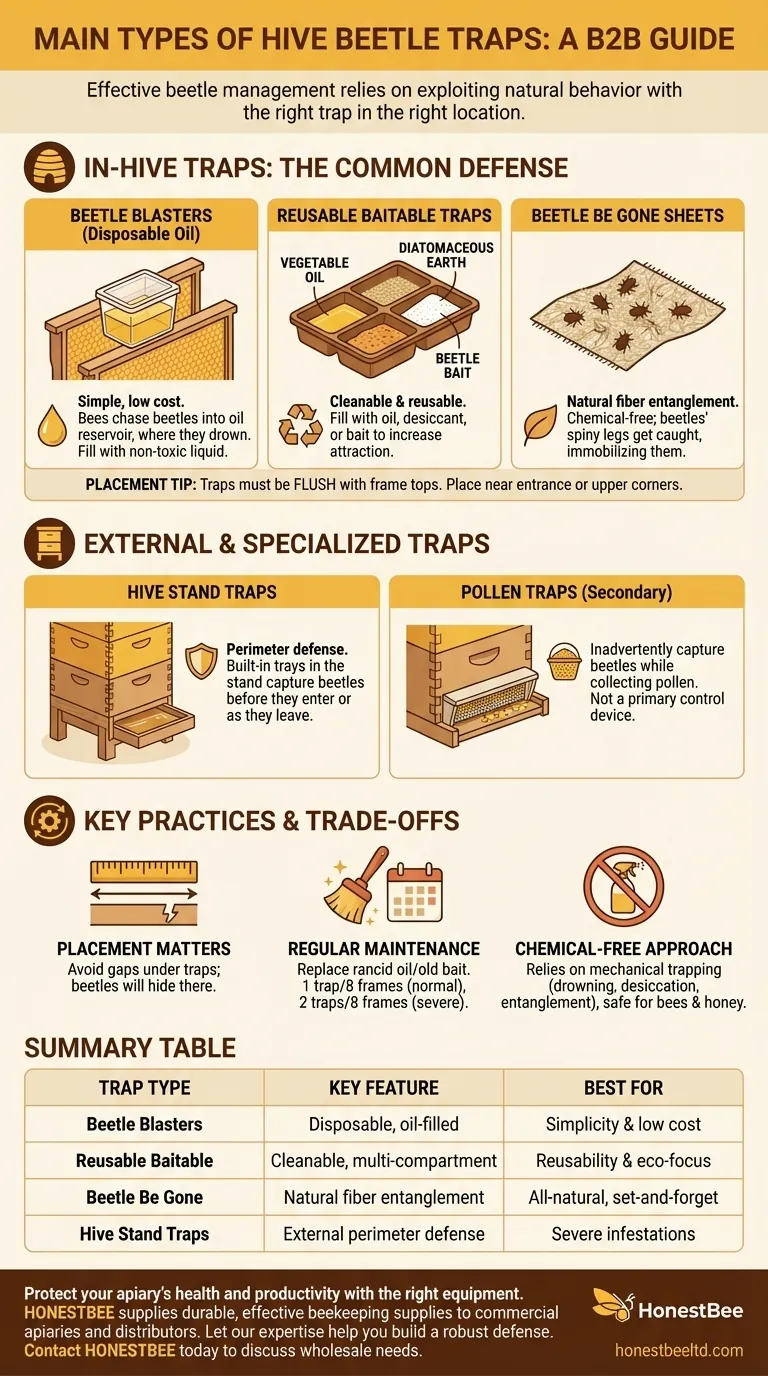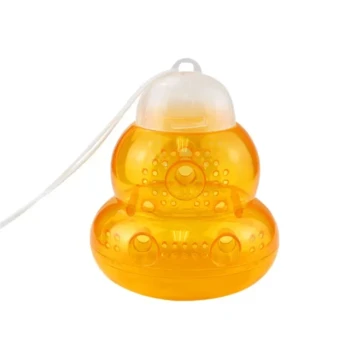The main types of hive beetle traps are primarily categorized by where they are placed within or around the hive. These include small in-hive traps that sit between the frames, larger trays that integrate into the hive stand or bottom board, and specialized sheets that entangle beetles. The most common varieties, like Beetle Blasters, are simple plastic reservoirs filled with oil that trap beetles as they try to hide from bees.
The key to controlling small hive beetles isn't just knowing the types of traps, but understanding their placement and purpose. Effective beetle management relies on exploiting the beetle's natural behavior—its desire to hide in dark crevices—by placing the right trap in the right location.

In-Hive Traps: The Most Common Defense
In-hive traps are the first line of defense for most beekeepers because they work directly where bees and beetles interact. They are designed to exploit the beetle's instinct to seek out small, dark spaces to hide from bees.
Beetle Blasters (Disposable Oil Traps)
Beetle Blasters are small, disposable plastic traps. They have a central reservoir for a lure and two side compartments you fill with a non-toxic liquid.
Bees chase the beetles, which run into the trap and drown in the oil. Their simplicity and low cost make them extremely popular for routine management.
Reusable Baitable Traps
These are slightly more complex traps, often with multiple trays or compartments. They are designed to be cleaned and reused season after season.
You can fill these traps with various substances, including vegetable oil, food-grade diatomaceous earth (which dehydrates beetles), or a specific beetle bait to increase their attractiveness.
Beetle Be Gone Sheets
These are not traps in the traditional sense but rather specialized cloths. They function like the "loop" side of a hook-and-loop fastener.
When beetles run across the cloth, their spiny legs become entangled in the fibers, immobilizing them. These sheets are a completely natural, chemical-free option placed where beetles are seen congregating.
External and Specialized Traps
While less common for hobbyists, external traps can be effective, especially for managing heavy beetle populations before they enter the main hive body.
Hive Stand Traps
Some hive stands are designed with built-in trays that can be filled with oil. As beetles try to crawl up the stand to enter the hive, or when they are driven out by bees, they may fall into the oil tray below.
This method creates a perimeter defense for the entire colony.
Pollen Traps
While their primary purpose is to collect pollen, some entrance-mounted pollen traps can inadvertently capture small hive beetles. This is typically a secondary benefit rather than their main function as a pest control device.
Understanding the Trade-offs and Best Practices
Simply placing a trap in the hive is not enough. Proper placement and maintenance are critical for success and to avoid creating new problems for your bees.
The Importance of Placement
Traps that sit between frames must be placed flush with the top of the frames. Any gap allows beetles to hide under the trap instead of going into it, completely defeating its purpose.
Place traps near the hive entrance or in the upper corners of the top hive body, as beetles often flee to these areas.
Trap Density and Maintenance
For normal maintenance, a good rule of thumb is one trap for every eight frames of bees. If you are dealing with a more significant infestation, increase this to two traps per eight frames.
You must monitor and service the traps regularly. Full traps are ineffective, and rancid oil or old bait needs to be replaced to maintain effectiveness and hive hygiene.
The Chemical-Free Approach
Nearly all modern hive beetle traps are designed to be chemical-free. They rely on mechanical trapping (drowning in oil, desiccation by diatomaceous earth, or entanglement) rather than pesticides, making them safe for bees and the honey supply.
Making the Right Choice for Your Hive
Selecting a trap depends on your management style, the severity of your beetle problem, and your budget.
- If your primary focus is simplicity and low cost: Disposable oil traps like Beetle Blasters are the most straightforward and effective starting point.
- If your primary focus is reusability and environmental impact: Choose a reusable, baitable trap that can be cleaned and refilled each season.
- If your primary focus is an all-natural, set-and-forget solution: Beetle Be Gone sheets offer a simple, non-liquid alternative for trapping beetles.
- If your primary focus is managing a severe infestation: A multi-pronged approach using a higher density of in-hive traps combined with an external hive stand trap is your most aggressive strategy.
Proactive and consistent trapping is a cornerstone of protecting your colony from the stress and damage caused by small hive beetles.
Summary Table:
| Trap Type | Key Feature | Best For |
|---|---|---|
| Beetle Blasters | Disposable, oil-filled | Simplicity & low cost |
| Reusable Baitable Traps | Cleanable, multi-compartment | Reusability & eco-focus |
| Beetle Be Gone Sheets | Natural fiber entanglement | All-natural, set-and-forget |
| Hive Stand Traps | External perimeter defense | Severe infestations |
Protect your apiary's health and productivity with the right equipment. HONESTBEE supplies durable, effective beekeeping supplies and equipment to commercial apiaries and distributors through our wholesale-focused operations. Let our expertise help you build a robust defense against hive beetles. Contact HONESTBEE today to discuss your wholesale needs and secure your colonies' future.
Visual Guide

Related Products
- Black Plastic Beetle Barn Hive Beetle Trap for Beehives
- Reusable Clear Small Hive Beetle Traps for Beehives Beetle Trapping Tools
- Reusable Aluminium Beetle Trap for Small Hive Beetles Silver Bullet
- Removable Washable Hive Beetle Trap Attractants for Small Hive Beetles
- Plastic Beetle Blaster Trap Beekeeping Tools and Supplies
People Also Ask
- How should beetle traps be placed in the hive? Achieve Perfect Flush Placement for Maximum Control
- What are the steps for installing hive beetle traps? A Guide to Effective Beetle Control
- Why are hive beetle traps important for beekeepers? Protect Your Hive from a Devastating Infestation
- What tips can help prevent hive beetle infestations? Build Strong Colonies & Master Apiary Hygiene
- What is the recommended number of beetle traps per hive? Optimize Your Hive's Beetle Defense



















